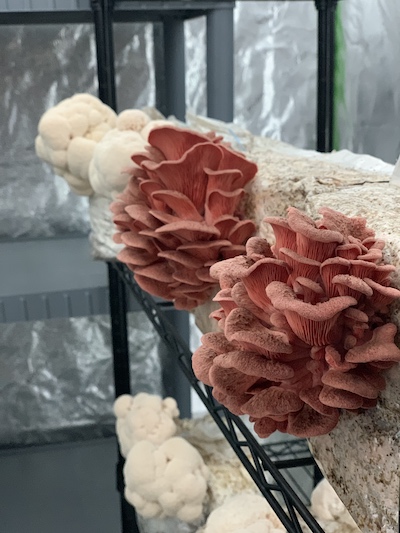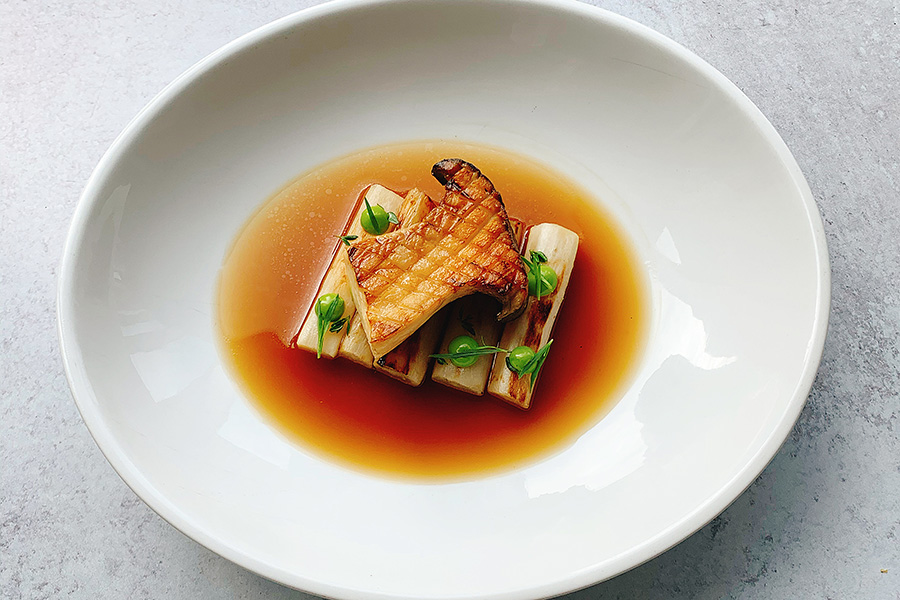There are few ingredients as exciting, mysterious and delicious to cook as mushrooms. There are also few ingredients whose costs stretch from budget-friendly to astronomical. (While most mushroom varieties can be purchased at your local supermarket for a reasonable price, some species can command up to $1,000 per pound.) Whether cultivated or wild, common or expensive, mushrooms impart unique texture and umami to recipes.

I recently spent time with Eric Wallace, the owner of an urban mushroom farm in Columbia, South Carolina called Vital Fungi. There, he cultivates exotic varieties of mushrooms like Pink Oyster, Black Pearl King and Lion's Mane for local chefs and mushroom-lovers.
Compared to other types of agriculture and farming, mushroom cultivation is a low-impact, low-resource form of food production. Eric believes in a regenerative approach to farming that encourages biodiversity and topsoil health, and in turn, produces healthy, nutrient-dense foods. His specialty mushrooms are a feast for the eyes, at once mysterious and beautiful.
Are Mushrooms Vegetables?
"Typically classed as vegetables, mushrooms are distinct substances called fungi and are more closely related to yeasts," advises Director of Nutrition Celine Beitchman.
Of the thousands of varieties of mushrooms that exist, humans can only eat a portion of those that live above ground. (Only about 20 mushroom varieties are commercially cultivated.)
The table mushrooms we eat are a variety called Agaricus bisporus, and they include portobello, cremini and white button mushrooms. At certain times of the year, a yellow-hued variety called chanterelles can be found at farmers markets. They're harvested in the fall and early winter in the Northwest, and from early spring to late summer on the east coast.
Sourcing and Storing Mushrooms
When sourcing mushrooms at the grocery store or farmers market, look for quality mushrooms with firm, blemish-free exteriors.
- A quality mushroom is whole with the stem attached and never slimy or fishy in smell. (I prefer picking my own versus buying pre-packaged and opt for whole over sliced.)
- Mushrooms should be dry, plump and springy.
- Fungi are active after harvesting and should be used shortly after purchase.
Store your mushrooms between 38 and 42 degrees Fahrenheit with room to aerate.
- Avoid plastic unless it is vented (like the clamshell containers for berries). This aeration allows for the gas exchange necessary to avoid sweating and spoilage. Completely sealed containers are hazardous and can create bacterial blooms that cause foodborne illness.
- Refrigeration slows down the mushroom metabolism, and they will last a week if loosely wrapped to prevent moisture or spoilage.
- Loose mushrooms should be stored in a reusable paper or Ziploc bag lined with a paper towel. You can leave the bag open.
- Dehydrate or dry mushrooms using a dehydrator or oven at 150 degrees Fahrenheit or less. Vacuum seal them in a bag for extended shelf-life.

Using Dried Mushrooms
When fresh mushrooms are not available, dried mushrooms are just as delicious and packed with flavor. I find dried mushrooms to be exceedingly versatile in dishes like risotto, soup and stir-fry. Many varieties like porcini and morels are easier to find dried than fresh, though they are pricey due to a short growing season.
- Store dried mushrooms in an air-tight container in a cool, dry cabinet for up to a year.
- Dried mushrooms should be rinsed to removed sediment and rehydrated in warm water for 30 minutes to an hour.
- Strain the leftover water to use as a broth for soups and stews.
How to Clean Mushrooms
One of the most frequently asked questions about cleaning mushrooms is whether to wash them or not.
- It is completely okay to wash whole common varieties of mushrooms like cremini, portabello, chanterelles or baby bellas right before cooking — but they'll absorb water like a sponge.
- Chefs gently clean mushrooms with a pastry brush to remove debris.
Are Mushrooms Good for You?
Mushrooms are a low-calorie food packed with vitamins, minerals and antioxidants, notably more protein and vitamin B12 than most fresh produce. Shiitakes are loaded with health benefits, including a unique compound called AHCC that stimulates the production and activity of natural killer cells and T cells, the immune system's first line of defense against viral infections and cancers.
"While mostly carbohydrate, unlike other 'plants,' a mushroom’s cell walls are made of chitin, a type of fiber so tough that humans can barely digest it," explains Chef Celine. "This cellular membrane is distinctly different from softer cellulose (e.g. insoluble fiber or roughage) that surrounds other edible plants which, in most cases, can be digested raw. Chitin is the main reason mushrooms are best served cooked — [this allows us to] access all of the nutrients inside the cell. It’s why a plate of mushroom ceviche may give you a bellyache as it makes its way through your GI tract intact."
"One amazing feature of all mushrooms is their ability to convert sunlight into D2 — an inactive form of vitamin D — which humans can digest and benefit from," adds Chef Celine.
"This is especially useful for individuals who avoid animal foods or who may avoid getting adequate sunlight and need to meet vitamin D requirements nonetheless. In addition to nutrients typically found in produce, mushrooms are also good sources of nutrients typically found in meats and grains — niacin, pantothenic acid, selenium, riboflavin and copper."
Both wild foraged and cultivated mushrooms can be dried in the sunlight to boost their vitamin D content, and with eight essential amino acids, they are just one shy of being a non-animal complete protein source.
"Beyond macronutrients and essential micronutrients, mushrooms also contain bioactive compounds that may improve human health," Chef Celine says.
"These include polysaccharide beta-glucans that research suggests play a role in insulin sensitivity and sugar-handling, support immune function, and may be cancer-preventative. And, mushroom polyphenols — that give distinct flavors and textures to each species — may play a role in reducing oxidative stress and thereby protect against degenerative brain disease."
Cooking Mushrooms
"When cooked, mushrooms are delicious sources of carbohydrates and glutamic acids that, when roasted or sautéed at high temperatures, yield savory, umami flavors that can mimic smoked meats," Chef Celine says. The taste can be earthy, buttery, savory and woodsy. Cooking releases all of the nutrients, aromas, and deep, earthy flavors and are essential for getting the most nutritional value.
See a student recipe with five types of mushrooms.
The best and simplest way to cook mushrooms is a simple simmer with ¼ cup water to a pound of mushrooms, then add oil and garlic, and finish with herbs, lemon or sherry vinegar. Pasta, stews and risottos are instantly elevated by adding mushrooms. Golden chanterelles are best when sautéed in fat with a pinch of sea salt, minced garlic, and deglazed with sherry vinegar or cream.

Ingredients
- 2 quarts vegetable or mushroom broth
- 2 tablespoons butter, plus 2 tablespoons for finishing (plant-based or regular)
- 2 tablespoons olive oil
- 2 cloves garlic, minced
- 1 onion, diced
- 2 cups Arborio rice
- 1 cup dry white wine or dry sherry
- Salt, to taste
Mushrooms
- ¼ cup water
- 4-6 cups mixed mushrooms, hand torn into large pieces (crimini, shiitake, wild mushrooms)
- 2 tablespoon dry sherry
- 2 tablespoons olive oil
- 4 cloves garlic, minced
- Salt, to taste
- Freshly ground black pepper
- 1 tablespoon butter
- 2 sprigs lemon thyme, chopped
- 2 tablespoons chives, chopped
- ½ lemon, juiced
- Maldon salt, for finishing
Directions
- Heat broth in a saucepan over medium heat and bring to a boil. Reduce heat to low.
- In a large heavy bottom pan or dutch oven, add butter and oil over medium heat. Sauté garlic and onion with a pinch of salt and cook 3-5 minutes.
- Add rice and stir until kernels are toasted and opaque.
- Deglaze with white wine and let it evaporate.
- Reduce heat to medium-low and add vegetable broth one ladle at a time until rice absorbs all liquid. Stir rice gently while cooking. Repeat this process until rice is al dente but maintains its shape (and is not fluffy). The rice is done when there is a slight bite to it and liquid is still present in the pot.
- Remove pot from heat, stir in butter, and season with salt.
- Serve with sautéed mushrooms.
Mushrooms
- Heat a large skillet over medium-high, add ¼ cup water and mushrooms. Gently stir until all water is evaporated and mushrooms have released their liquid and wilted slightly.
- Add sherry and cook until the liquid evaporates.
- Add oil and sauté another 10 minutes or until mushroom edges are lightly golden brown.
- Add garlic and cook another minute.
- Season with kosher salt and freshly ground black pepper, tossing occasionally.
- Remove from heat and toss with butter, herbs and lemon juice.
- Finish with a pinch of Maldon salt.
Work with mushrooms and more whole foods in Plant-Based Culinary Arts.





